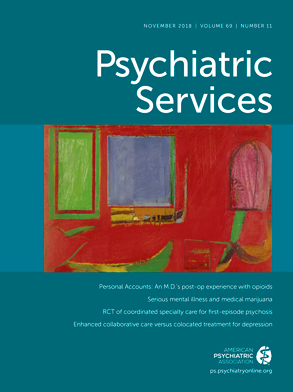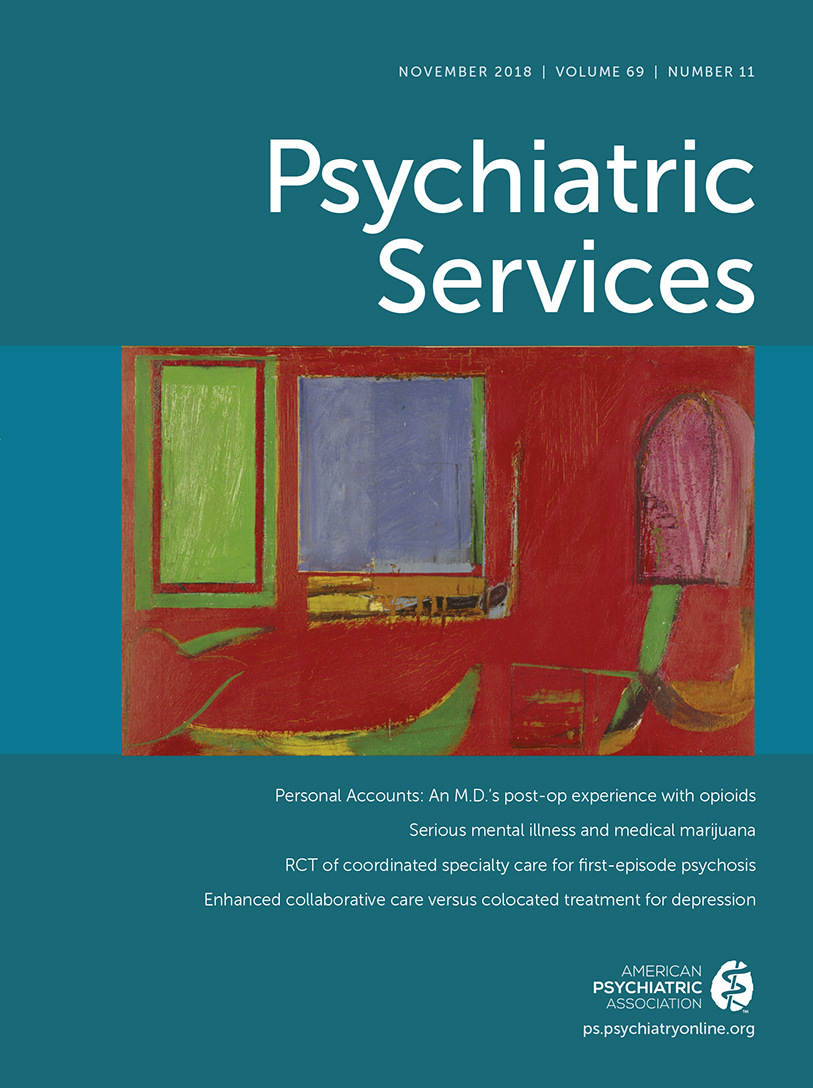Thirty-three states and Washington, D.C., have substantially reduced legal barriers to using marijuana (
1), either by legalizing medical or recreational marijuana or by reducing legal penalties for possession. As a result, the marijuana industry is booming—in Washington State alone, over 20,000 pounds of marijuana are produced each month. To advance sales, marijuana-related businesses have developed an array of new products, are advertising heavily, and are profiling consumers. These changes in the legal and commercial landscape introduce many questions for the mental health community. What is the evidence that cannabinoids can be harmful or helpful to people with serious mental illness? How will commercialization of recreational and so-called medical cannabis affect those who are vulnerable to addiction, such as persons with serious mental illness (
2)?
The impact of marijuana depends upon the consumed potency and dose of its major psychoactive components, tetrahydrocannabinol (THC) and cannabidiol (CBD), which have very different psychiatric effects. THC produces feelings of euphoria, can engender paranoia and anxiety, and has addiction liability, whereas CBD does not have these effects, may reduce psychosis, and is not thought to be addictive (
3). The amount and ratio of these compounds in products available on the street and in legal dispensaries are highly variable. Legal outlets provide cannabis products with a range of THC:CBD ratios. Generally, the average amount of THC in typical street marijuana has tripled in the past 20 years, from 4% to 12% (
4), whereas the proportion of CBD has declined, resulting in products that are putatively more psychotogenic.
Consequently, careful consideration of the type and amount of marijuana constituents is needed when discussing marijuana’s possible effects on people with serious mental illness. Marijuana that is high in THC causes psychotic symptoms among people with and without psychosis. It is associated—when used heavily—with increased risk of schizophrenia among adolescents and worsens symptoms and course of illness among people with schizophrenia (
5). Similarly, heavy use of high-THC marijuana is associated with increased risk of developing mania and depression as well as exacerbation of mania and depression among people with an existing mood disorder. Although many people believe that marijuana is helpful for people with posttraumatic stress disorder (PTSD), not a single prospective, controlled trial of any type of marijuana for people with PTSD has been published, and retrospective studies have reported mixed findings (
6).
Whether CBD is helpful to people with serious mental illness is a question of intense interest. In early 2018, a placebo-controlled trial reported that very high doses of oral CBD (without THC) reduced psychotic symptoms among people with schizophrenia (
7). Some strains of moderate-CBD, low-THC marijuana are available via state-registered dispensaries, but their impact on people with mental illness is not clear. Overall, although businesses promote particular ratios of THC and CBD in marijuana for specific therapeutic indications, empirical support for these claimed effects on mental illness is lacking.
Comorbid medical conditions and prescription opioid use are common among people with serious mental illness, and some patients and clinicians have a strong interest in using marijuana rather than opiates for pain. A 2017 summary of the literature indicated that there is strong evidence for a modest therapeutic effect of marijuana on chronic pain and that the effect is similar to that of nonaddictive alternatives (
8). Regarding evidence for other indications, there is adequate evidence for chemotherapy-induced vomiting and multiple sclerosis spasticity as well as new evidence of indications for CBD in two rare, severe forms of childhood epilepsy that could lead to an FDA-approved form of CBD (
9). However, evidence for all other indications was deemed inadequate. Furthermore, marijuana use is linked with many adverse health effects, including low birth weight, pulmonary symptoms, motor vehicle accidents, impaired cognition, low school and work performance, and the development of addiction among 10% to 20% of users (
10). Given the overall health, mental health, and addiction risks of marijuana use, especially among people with serious mental illness, and the many nonaddictive options for treatment of pain and other health conditions, use of medical marijuana among people with serious mental illness is concerning.
Medical Marijuana Programs
Despite the lack of strong evidence for efficacy and the known risks of marijuana use, states have implemented a variety of medical marijuana programs. For example, in New Hampshire, the state legislature has identified 21 diagnoses that are eligible for treatment with medical marijuana, including moderate chronic pain and PTSD. If a licensed clinician determines that a patient has one of the 21 approved diagnoses, he or she may provide the patient with a registry identification card. People with cards may buy up to two ounces of marijuana every 10 days at an “alternative treatment center.” These for-profit businesses are licensed by the state to grow and sell marijuana products, including edibles, vaping oils, lotions, transdermal patches, and plant material for smoking. Purchases may be made online or in person from a large menu of products with appealing, nonmedical names and THC potencies that are much higher than potencies studied for medical indications such as pain. For example, products include Gorilla Glue Ethanol Shatter, with 75.8% THC potency; Billy Club Sativa, with 19.04% THC and <.05% CBD potencies; and Shark Shock Flower, with 9.21% THC and 11.88% CBD potencies (
11).
Although product labeling of medical marijuana is required, recent studies suggest that regulatory infrastructures do not yet ensure product safety or consistency. For example, in various states, a third of samples were adulterated with pesticides (
12), product labeling was incorrect from 60% to 80% of the time (
13,
14), and laboratory testing results were inconsistent (
15).
Clinical Example
In our clinical experience, many people with serious mental illness access medical marijuana for an array of indications, and many of them have experienced problems, including worsening psychosis, anxiety, cognitive impairment, and addiction. Community clinicians may not fully understand the mental health and addiction liabilities of THC, and they may not coordinate their recommendation for marijuana use with other providers. Thus the potential benefits of CBD may be overemphasized compared with the potential harm from THC. The following case exemplifies the complications that people with serious mental illness may experience when using medical marijuana.
Mr. D. is a 50-year-old man with well-controlled bipolar disorder and chronic back pain from a car accident that occurred 10 years earlier. When his pain recently worsened, his primary care provider (PCP) provided a marijuana card and guidance for use of medical marijuana for pain, which he used in the evening about three times weekly, with improvements in sleep and pain. Nine months later, however, he presented to his psychiatrist with concerns that he was “going crazy with side effects from the mood stabilizers.” He appeared confused, disorganized, and hypomanic. His psychiatrist learned that Mr. D. had increased his marijuana use to address increased pain, with his PCP’s advice, to three times daily. The psychiatrist provided education and discussed the potential risks of marijuana use with Mr. D., as she would when discussing any medicine. In this case, the destabilizing effects of THC on cognition and mood, in addition to its addiction liability, were particularly relevant. Even with this information, Mr. D. strongly wished to continue using marijuana for pain, so he and the psychiatrist agreed that he would switch to a high-CBD, low-THC product and reduce use to once in the evening. They agreed that if problems with cognition and hypomania continued, he would cut back further. The psychiatrist called the PCP to coordinate Mr. D’s care, and Mr. D.’s condition restabilized over the following weeks.
Conclusions
People with serious mental illness may experience many adverse effects and more easily develop an addiction with marijuana use. Further research is needed to assess the potential benefits of CBD among people with serious mental illness and to clarify whether any level of THC exposure by this group is safe. It is also important to evaluate whether use of marijuana affects use of other substances, such as opioids, among people with serious mental illness. Given the U.S. trajectory toward legalization of marijuana, clinicians need to incorporate knowledge about marijuana into their clinical work, communicate with providers who endorse marijuana and with dispensaries that provide it, and also provide guidance in order to reduce harms among people with serious mental illness who choose to use marijuana.

